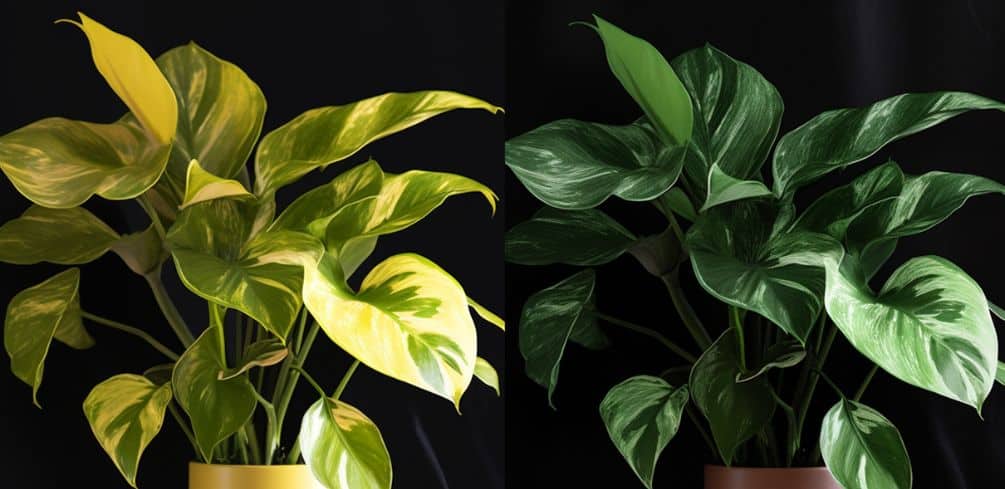
Are you looking to add a touch of verdant charm to your living space but can’t decide between the Philodendron Moonlight and Golden Goddess? You’re in luck! This article will guide you through the unique characteristics, ideal growing conditions, care requirements, similarities, and distinct features of these two stunning philodendron varieties.
With a deeper understanding of these lovely plants, you can make an informed decision on which one would best suit your home or office environment. Dive into the world of Philodendrons as we explore the subtle nuances that set Moonlight and Golden Goddess apart from each other.
Both are popular among plant enthusiasts for their striking foliage and easy-care nature, but there’s more than meets the eye when it comes to these lush green beauties.
Characteristics of Each Plant Variety
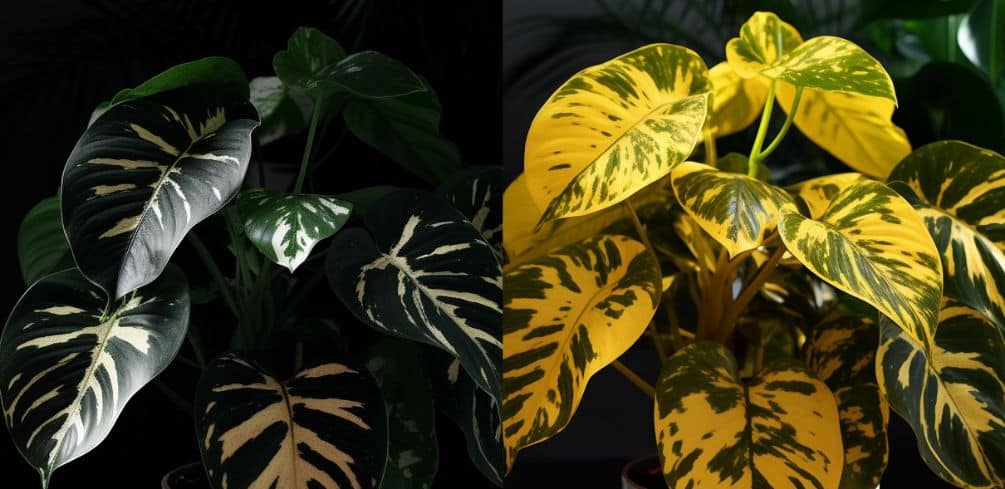
It’s like comparing apples to oranges when diving into the unique traits of these two vibrant and alluring plant varieties. Philodendron Moonlight and Golden Goddess each exhibit their own distinct characteristics, making it a pleasure for plant enthusiasts to explore the differences between them.
From leaf shapes to color variations, growth habits to propagation methods, and even pest resistance, both plants have their own strengths that set them apart from one another.
Philodendron Moonlight boasts heart-shaped leaves that emerge with a bright lime green hue before maturing to a darker shade of green. Its growth habit tends to be more compact and bushy, making it an ideal choice for smaller spaces or as a tabletop accent.
This variety is known for its ease of propagation through stem cuttings or air layering methods, allowing you to share your love for this plant with friends and family. Check out other Philodendron types.
On the other hand, Golden Goddess features elongated leaves with a striking golden-yellow color that adds warmth and visual interest in any setting. It grows more upright compared to Moonlight but can still be maintained at a manageable size with regular pruning. Propagation of Golden Goddess is typically done through division or stem cuttings.
When it comes down to pest resistance, Philodendron Moonlight has a slight edge over Golden Goddess due in part to its thicker foliage which makes it less susceptible to common pests such as spider mites or aphids. However, both varieties should still be monitored regularly for any signs of infestation and treated accordingly if needed.
Ideal Growing Conditions
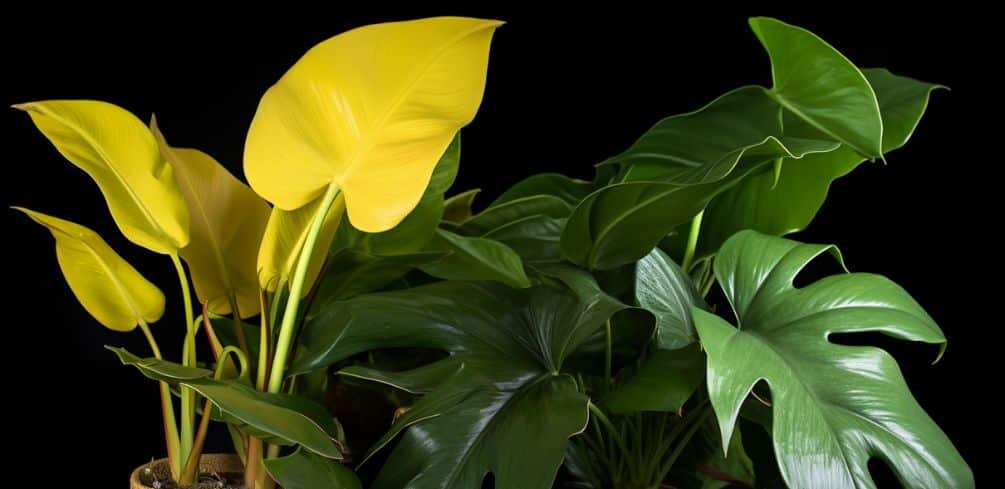
You’ll be over the moon when you discover the perfect environment for these stunning plants to thrive! Philodendron Moonlight and Golden Goddess have some similar growing conditions, but they also have their unique preferences.
By providing them with the right temperature, humidity levels, soil mixtures, light requirements, and fertilization frequency, you can enjoy lush and healthy foliage in no time.
- Temperature preferences: Both Philodendron Moonlight and Golden Goddess prefer warm temperatures. They grow best in a range of 65-85°F (18-29°C). Avoid placing them near cold drafts or air conditioners, as these can cause stress or even damage to the plants. In colder months, make sure to keep them away from windows that may let in cold drafts.
- Humidity levels & Soil mixtures: These philodendrons love high humidity levels of around 60% or higher. You can achieve this by placing a humidifier nearby or using a pebble tray filled with water under the plant pots. As for soil mixtures, both varieties appreciate well-draining soil that retains moisture without becoming soggy. A blend of potting soil with perlite or orchid bark is ideal.
- Light requirements & Fertilization frequency: Bright indirect light is perfect for both Moonlight and Golden Goddess philodendrons; avoid direct sunlight as it may scorch their leaves. Near an east-facing window would be an excellent spot for these beauties! When it comes to fertilization frequency, feed them every four to six weeks during the growing season (spring through summer) using a balanced liquid fertilizer diluted at half strength.
With proper care and attention paid to temperature preferences, humidity levels, soil mixtures, light requirements, and fertilization frequency – your Philodendron Moonlight and Golden Goddess will reward you with vibrant growth year-round!
Remember that consistency is key; monitor your plants and adjust their conditions as needed. As you learn to read the signals from these tropical beauties, you’ll become a master at providing them with the perfect environment in which to flourish.
Care Requirements and Tips
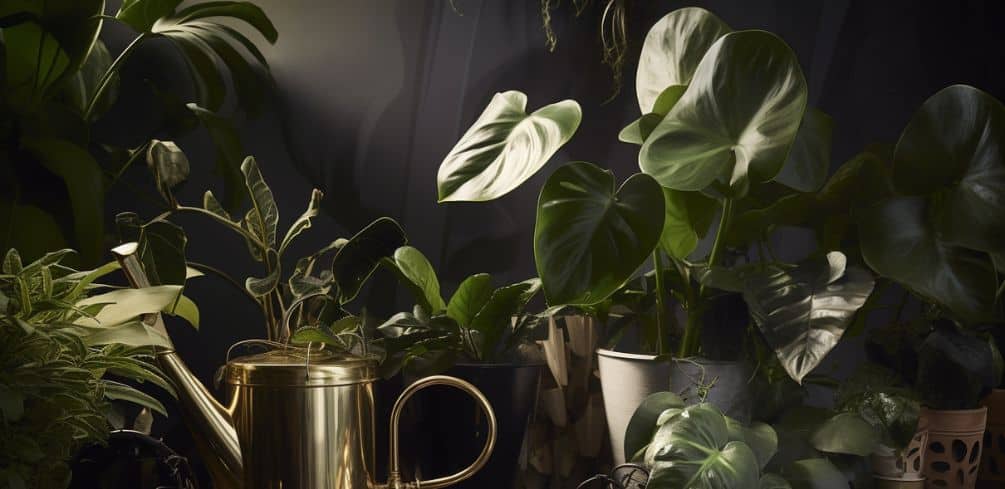
Caring for these stunning plants isn’t rocket science; with a few essential tips under your belt, you’ll quickly become an expert at keeping them happy and healthy.
When it comes to watering frequency, both Philodendron Moonlight and Golden Goddess prefer their soil to be consistently moist but not soggy. A general rule of thumb is to water them when the top inch of the soil feels dry to the touch.
Overwatering can lead to root rot, while underwatering will cause their leaves to droop or curl.
As for fertilizing, use a balanced liquid fertilizer diluted to half-strength every 4-6 weeks during the growing season (spring through summer) and reduce it down to once every 2-3 months in fall and winter.
Pruning techniques are essential for maintaining the shape and size of your Philodendron Moonlight or Golden Goddess plant. Regularly remove any yellowing or dead leaves by cutting them off close to the base using clean, sharp scissors or pruning shears.
Avoid tearing leaves with your hands, as this could damage the plant’s stem. If you notice that your plant becomes leggy, meaning it has long stems with sparse foliage, pinch back new growth tips periodically throughout the year – this encourages bushier growth habits.
To prevent pests like spider mites or mealybugs from infesting your precious plants, keep their foliage clean by wiping it down with a damp cloth biweekly and inspecting regularly for signs of infestation.
When it comes time for repotting your Philodendron Moonlight or Golden Goddess, typically once every 1-2 years depending on its growth rate, choose a container that is one size larger than its current pot with drainage holes at the bottom.
Gently remove the plant from its original pot by carefully loosening its roots if they seem compacted or circling around themselves – this helps encourage better root growth in their new home.
Fill the new pot with a well-draining, peat-based potting mix and place your plant inside, making sure to position it at the same level in the soil as before. Water thoroughly after repotting and give it some time to adjust to its new environment before resuming regular care practices like fertilizing and pruning.
How long do these plants last? Do plants die of old age?
Similarities and Distinct Features
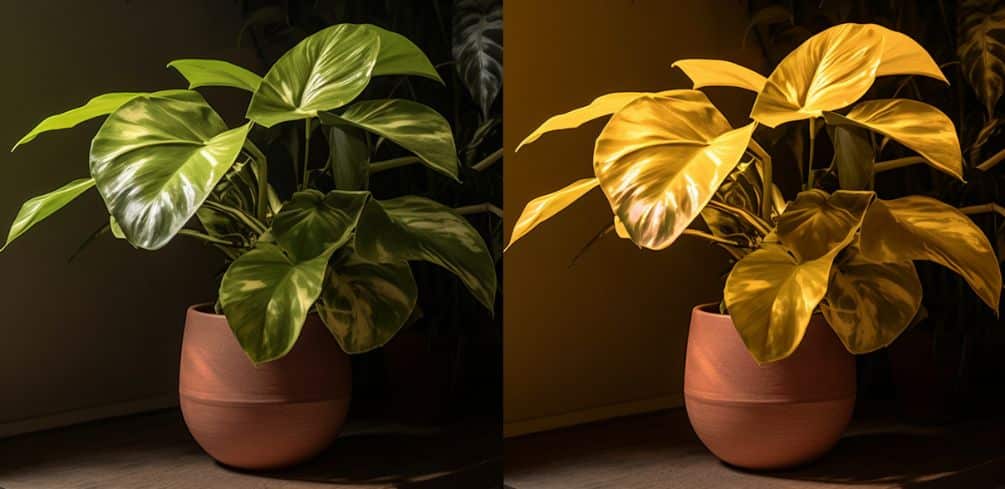
Now that you’re familiar with their care requirements, let’s dive into the similarities and distinct features of these two captivating plants. Both Philodendron Moonlight and Golden Goddess are known for their luminous foliage and vibrant growth, making them popular choices among plant enthusiasts.
They thrive in similar conditions, including bright indirect light, well-draining soil, and a humid environment.
Additionally, both plants exhibit an impressive aesthetic impact in any space they inhabit. One key difference between the two lies in their leaf shape and color intensity.
The Philodendron Moonlight boasts large, heart-shaped leaves that emerge with a bright lime-green hue before maturing to a darker green shade. This striking contrast adds depth and visual interest to your indoor garden.
On the other hand, the Golden Goddess features smaller leaves with a more elongated shape and maintains its golden-yellow color throughout its life cycle. The continuous warmth of its foliage creates an inviting atmosphere in your home.
Despite these differences in appearance, both Philodendron Moonlight and Golden Goddess make stunning additions to any plant collection due to their unique characteristics.
Whether you prefer the dramatic transformation of the Moonlight’s leaves or the consistent radiance of the Golden Goddess’s hue, you can’t go wrong with either choice.
Ultimately, it comes down to personal preference as you consider which plant best suits your taste and complements your existing interior decor while enjoying their shared traits of luminous foliage and vibrant growth that bring life to any space they occupy.
Making the Right Choice for Your Space
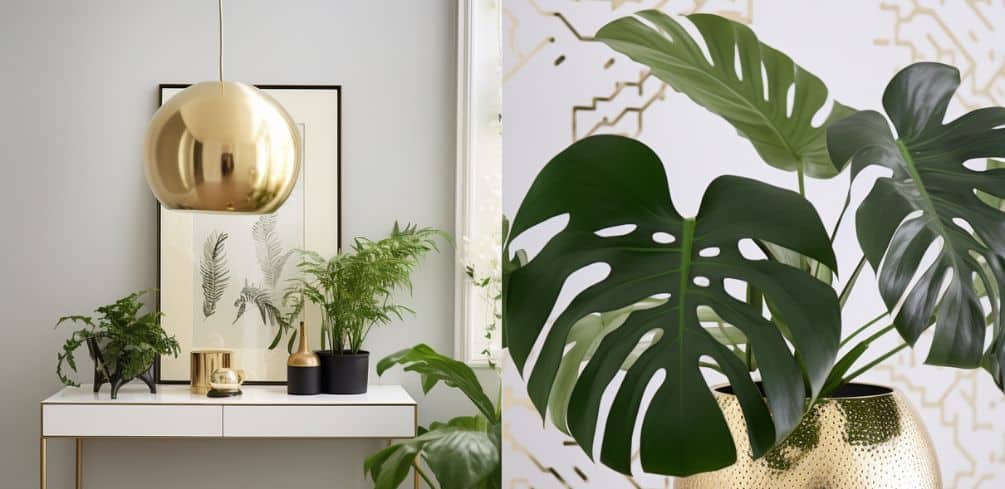
Deciding between these two captivating plants might feel like a challenge, but by evaluating your space and personal preferences, you’ll find the perfect radiant addition to your indoor garden. Take into account factors such as space aesthetics, container choices, plant symbolism, companion plants, and budget considerations when making your decision.
Both the Philodendron Moonlight and Golden Goddess bring their own unique charm to any space; however, understanding how each plant complements your existing décor and environment will help you make an informed choice.
Consider the overall aesthetic of your space when choosing between these two stunning species. The Philodendron Moonlight’s vibrant lime-green leaves can create a refreshing pop of color in a room with neutral tones or add depth to an already colorful area.
On the other hand, the Golden Goddess has striking gold-hued foliage that can enhance warm-toned spaces or introduce a touch of elegance to minimalist environments.
When selecting containers for either plant, consider materials and colors that complement both the plant itself and its surroundings.
You may also want to ponder over each plant’s symbolism: Moonlight reflects growth and rejuvenation, while Golden Goddess symbolizes wealth and prosperity. Additionally, think about potential companion plants that would harmoniously coexist with either option—some popular choices include pothos varieties for their trailing beauty or snake plants for their architectural appeal.
Budget considerations are essential when selecting the right philodendron variety for your space. While both species are relatively low-maintenance in terms of care requirements—which often translates into cost savings—there may be differences in price points based on availability or demand within local markets.
It’s also crucial to factor in costs related to containers, potting mixtures specifically designed for philodendrons (to promote optimal growth), and any desired additional decorative elements such as stands or hangers.
Ultimately, it comes down to which variety resonates most with you personally while also fitting seamlessly within your home or office space. By examining these various factors, you can confidently choose between the Philodendron Moonlight and Golden Goddess to enhance your indoor garden beautifully.
Ever wonder if indoor plants attract bugs- find out here.
Conclusion
Imagine your living space transformed into a lush, vibrant oasis with the shimmering leaves of a golden goddess or the soothing glow of moonlight casting their breathtaking beauty.
These Philodendron varieties, each unique in appearance and temperament, can bring that dream to life. Make the choice that best suits you, and watch as your indoor garden becomes a sanctuary for relaxation and inspiration.
Embrace these stunning plants and let them work their botanical magic on your surroundings. There are also other big leaved indoor plants to consider.


